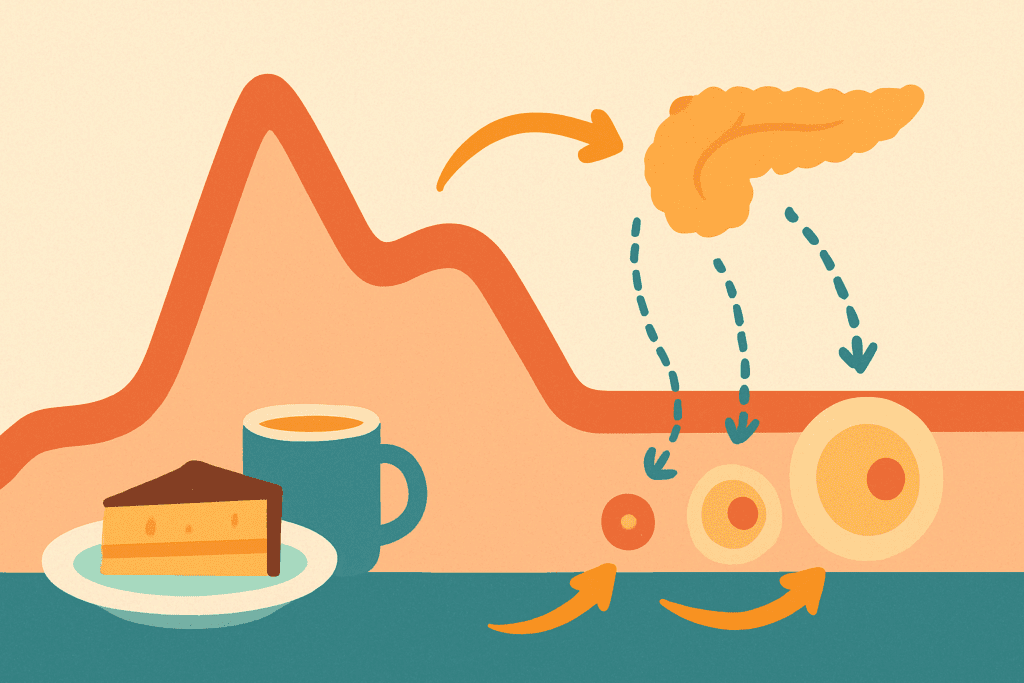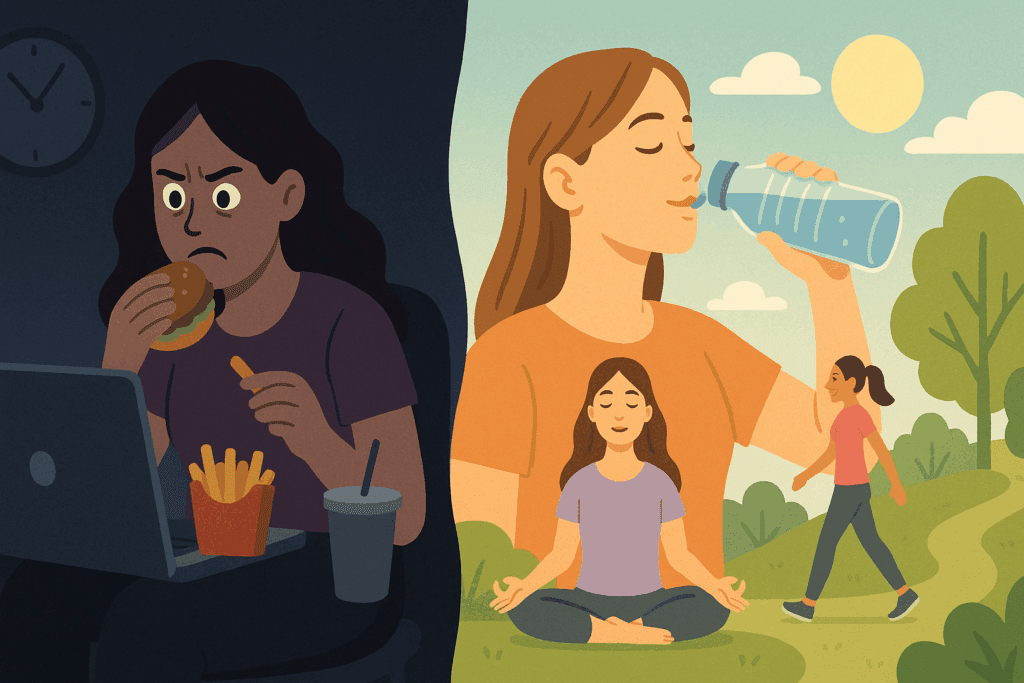Many of us have experienced it—that sudden wave of fatigue, brain fog, and irritability that hits out of nowhere after eating something sweet or carb-heavy. It might feel like your energy has been pulled out from under you, and in many ways, that’s exactly what’s happening. This physiological phenomenon is widely known as sugar crashing, and it plays a more significant role in our overall well-being than most people realize. Learning to define sugar crash correctly and identify the signs of a carb crash can empower you to make smarter dietary choices that stabilize energy and improve long-term health.
Understanding the nature of a sugar crash isn’t just about avoiding uncomfortable symptoms. It’s about understanding how our body uses food as fuel and recognizing when our internal systems are out of balance. From a metabolic perspective, sugar crashes indicate disrupted glucose regulation, which can increase the risk of insulin resistance, weight gain, and even chronic disease when left unmanaged. Thankfully, there are natural, evidence-based strategies to avoid these sudden drops in energy, and this article offers expert insight into how you can put those strategies into practice.
You may also like: Why Am I Craving Sweets All of a Sudden? Expert-Backed Reasons and How to Stop Sugar Cravings Naturally

What Is a Sugar Crash and Why Does It Matter?
To clearly define sugar crash, think of it as your body’s overreaction to a rapid increase in blood glucose. When you consume high-sugar or refined carbohydrate foods—such as soda, candy, or white bread—your blood sugar rises quickly. In response, your pancreas releases a large amount of insulin to shuttle glucose from your bloodstream into your cells. Sometimes, that insulin release is too aggressive, especially if your diet is inconsistent or you’re insulin sensitive. This results in a rapid drop in blood sugar—what we call a sugar crashing episode.
A carb crash isn’t just about low energy—it can affect your mood, mental clarity, appetite, and metabolism. This drop in blood sugar often happens one to three hours after eating and can leave you feeling tired, dizzy, irritable, or intensely hungry again. The problem is that many people respond to these symptoms by consuming more sugar, which perpetuates a vicious cycle. When you understand the true nature of this metabolic dip, you can start to work with your body instead of against it, using diet and lifestyle strategies to keep your energy steady and your mind clear.

The Physiology Behind Sugar Crashing: How It Works
The human body is designed to maintain blood sugar within a narrow range because glucose is our primary source of fuel—especially for the brain. When we consume food, especially carbohydrates, it gets broken down into glucose and enters the bloodstream. This prompts the pancreas to release insulin, a hormone that helps transport glucose into cells for immediate energy or storage. The problem arises when we consume a large amount of simple carbohydrates that digest quickly.
This rapid influx of sugar into the blood leads to a sharp insulin spike, which can cause your blood sugar to plummet shortly after, triggering a carb crash. This process can be exacerbated by factors like eating on an empty stomach, drinking alcohol, or consuming caffeine alongside sugary foods. All of these amplify the rate at which sugar is absorbed and insulin is released. What follows is a crash in energy and cognition—sometimes so profound that people feel disoriented or need to lie down.
Repeated sugar crashing is a sign that your body’s glucose management is under strain. It can lead to insulin resistance over time, which is a risk factor for metabolic syndrome and type 2 diabetes. Understanding these mechanisms is critical to long-term health—not just because of how they make you feel today, but because of what they signal for tomorrow.

How to Recognize When You’re in a Carb Crash
Recognizing the symptoms of a sugar crash can help you interrupt the cycle before it becomes chronic. The signs are both physical and cognitive. You may feel sudden exhaustion, shakiness, light-headedness, sweating, or a fluttering heartbeat. At the same time, your mind may feel foggy, irritable, or anxious. These symptoms often hit within one to three hours after a high-carb or high-sugar meal.
Another classic sign of a carb crash is intense hunger—even if you recently ate. This is because your body perceives low blood sugar as a crisis and sends out hunger signals to prompt you to eat again, often pushing you toward more quick carbs. The irony is that reaching for another sugar-laden snack just restarts the cycle, leading to more crashes throughout the day.
If you consistently feel drained or unfocused after meals, it may be time to look at your dietary patterns more closely. A good starting point is to keep a journal of what you eat and how you feel afterward. Patterns will begin to emerge, and you’ll likely find that meals high in refined carbs are closely linked to sugar crashing symptoms.

Meal Composition Matters: How the Right Foods Can Prevent Sugar Crashing
The types of carbohydrates you consume—and what you pair them with—make a huge difference in whether or not you experience a sugar crash. Not all carbs are created equal. Simple carbohydrates like white rice, sugary cereals, and pastries digest quickly and spike blood glucose. Complex carbohydrates such as lentils, quinoa, and steel-cut oats digest more slowly, causing a gradual rise in blood sugar and a lower insulin response.
When you combine carbohydrates with healthy fats, protein, and fiber, digestion slows down even more, providing a steadier stream of glucose to your bloodstream. This is one of the most effective ways to prevent carb crash episodes. For example, topping whole-grain toast with avocado or pairing fruit with a handful of nuts can significantly reduce the likelihood of a post-meal energy dip.
Building balanced meals that contain macronutrients in the right proportions will go a long way in keeping your energy even. A good rule of thumb is to fill half your plate with non-starchy vegetables, a quarter with lean protein, and the remaining quarter with whole grains or starchy vegetables. This not only supports glucose balance but also promotes satiety and reduces cravings later in the day.

Lifestyle Habits That Contribute to or Prevent Sugar Crashing
Diet is a cornerstone of blood sugar stability, but it’s not the only factor. Lifestyle habits like sleep, stress, hydration, and physical activity all play key roles in glucose regulation and can either amplify or help prevent sugar crashing episodes.
Sleep deprivation impairs insulin sensitivity, which means your body has to release more insulin to achieve the same glucose-lowering effect. This raises the likelihood of both glucose spikes and subsequent carb crash symptoms. Likewise, chronic stress elevates cortisol levels, which increases blood sugar and alters appetite regulation, often leading to unhealthy food choices that further destabilize your system.
Regular physical activity, on the other hand, improves insulin sensitivity and glucose uptake by muscle cells. Even moderate activities like walking after a meal can help flatten the glucose curve and reduce the likelihood of a crash. Hydration also matters—dehydration can concentrate blood sugar and interfere with your body’s ability to regulate insulin properly.
Incorporating mindfulness, exercise, consistent sleep, and stress-reduction techniques into your routine will compound the effects of a healthy diet. These habits act as a buffer against the blood sugar swings that lead to sugar crashing and help you feel more resilient and energized throughout the day.
How to Recover from a Sugar Crash Without Making It Worse
If you find yourself deep in a carb crash, it’s tempting to grab the quickest, easiest source of sugar to feel better. But doing so can perpetuate the cycle. Instead, focus on stabilizing your blood sugar gently and gradually. A balanced snack that includes protein, fat, and fiber is your best bet—something like a hard-boiled egg with a few slices of cucumber, or a spoonful of almond butter on a rice cake.
Drinking water can also help your body metabolize excess glucose and reduce the intensity of symptoms. If possible, engage in light movement, like a 10-minute walk, to help your muscles absorb circulating glucose more effectively. Resist the urge to over-correct with caffeine or more sugar; doing so often intensifies the rebound effect.
Taking a moment to rest, breathe, and reflect on what might have triggered the crash is also valuable. Use it as a learning opportunity. Keeping a journal of what you ate, how long after you crashed, and what you did to feel better can help you identify patterns and build more effective prevention strategies moving forward.

The Long-Term Risks of Frequent Sugar Crashing
Occasional sugar crashing isn’t necessarily harmful, but if it happens often, it may indicate a deeper problem with glucose regulation. Chronically unstable blood sugar is associated with insulin resistance, increased fat storage, systemic inflammation, and greater risk for type 2 diabetes. If you’re experiencing frequent carb crash episodes, it may be a sign that your metabolism is struggling to maintain balance.
Over time, this can have a ripple effect on other systems in the body, including hormonal balance, cardiovascular health, cognitive function, and mood regulation. Many people also find that repeated sugar crashes lead to emotional eating patterns, especially cravings for fast, processed foods that worsen the underlying issue.
It’s important to take these signs seriously and not brush them off as “normal tiredness.” When you begin to recognize the early indicators of dysregulated blood sugar, you can intervene early, protect your long-term health, and avoid the complications that come from chronically unbalanced energy metabolism.

Frequently Asked Questions (FAQ): Understanding and Managing Sugar Crashing and Carb Crashes
1. Can sugar crashing affect mental health or cognitive performance over time?
Yes, sugar crashing can have a surprisingly significant impact on mental health and cognitive performance, especially when it occurs frequently. When blood sugar levels drop suddenly, the brain is temporarily deprived of its primary fuel source—glucose—leading to impaired concentration, mood swings, and even anxiety or depressive symptoms in some individuals. Chronic carb crash episodes may also disrupt sleep patterns, increase cortisol levels, and exacerbate symptoms of mental fatigue. Although short-term effects are more noticeable, persistent sugar crashing has been associated with reduced resilience to stress and difficulty with executive function tasks like decision-making and memory. Learning how to prevent a carb crash through dietary balance is not only beneficial for physical health but also vital for maintaining psychological well-being.
2. Are there differences in sugar crashing symptoms between men and women?
While the physiological process behind sugar crashing is generally the same for all adults, emerging research suggests that men and women may experience symptoms differently due to hormonal variations. Women, particularly during the luteal phase of their menstrual cycle, may be more sensitive to fluctuations in blood glucose and thus more prone to mood-related symptoms during a carb crash. Estrogen and progesterone levels can influence insulin sensitivity, meaning that women may feel the effects of sugar crashing more acutely at certain times of the month. On the other hand, men may be more prone to the fatigue and cognitive fog aspects of a crash. Understanding these sex-based differences can help tailor prevention strategies, such as modifying carbohydrate intake based on hormonal changes.
3. How does intermittent fasting affect the likelihood of a carb crash?
Intermittent fasting, when practiced without mindful refeeding, can increase the risk of sugar crashing in certain individuals. While fasting can improve insulin sensitivity over time, breaking a fast with a high-glycemic meal can cause a dramatic glucose spike followed by a sharp insulin response, setting the stage for a carb crash. If one doesn’t carefully plan nutrient-dense, balanced meals to break the fast, the chances of sugar crashing soon after increase. To mitigate this, it’s best to break a fast with meals rich in fiber, protein, and healthy fats rather than refined carbs or sugary foods. Fasting may offer benefits, but without an understanding of how to define sugar crash triggers in this context, it may backfire for some people.
4. Can sugar crashing impact athletic performance or workout recovery?
Absolutely. Athletes or highly active individuals who experience sugar crashing may see a direct drop in energy, coordination, and stamina—especially during or shortly after workouts. A carb crash can interrupt post-workout recovery by limiting the body’s ability to replenish glycogen stores efficiently. Consuming refined carbs before exercise may seem helpful for a quick energy boost, but if not balanced with protein or fiber, it can result in a mid-workout sugar crash. This leads to fatigue and compromised performance, particularly in endurance sports. Athletes should consider nutrient timing and avoid high-sugar pre-workout meals if they want to maintain peak output and avoid reactive hypoglycemia during training.
5. What role does gut health play in sugar crashing and carb metabolism?
Emerging science reveals that gut microbiota may influence blood glucose responses and the likelihood of sugar crashing. Individuals with imbalanced or less diverse gut bacteria may have exaggerated insulin reactions to certain carbohydrates, increasing the risk of a carb crash. Specific strains of beneficial bacteria appear to support slower glucose absorption and better insulin signaling, potentially mitigating the postprandial dip associated with sugar crashing. Probiotics and prebiotic-rich foods like asparagus, garlic, and legumes can support gut health and may reduce metabolic volatility. By optimizing digestion and microbiome balance, individuals may be able to reduce the frequency and severity of blood sugar crashes through an indirect but powerful mechanism.
6. Are sugar crashing episodes linked to long-term metabolic disorders like insulin resistance?
Yes, frequent episodes of sugar crashing can be a red flag for underlying metabolic dysfunction, including early-stage insulin resistance. While a single carb crash isn’t necessarily harmful, a pattern of crashes may indicate that your body is struggling to regulate insulin properly. Over time, these fluctuations place chronic stress on the pancreas, potentially leading to diminished insulin sensitivity and increased risk for metabolic syndrome or type 2 diabetes. Recognizing the signs early and learning how to define sugar crash patterns in your own eating habits is essential for prevention. Regular glucose monitoring, dietary adjustments, and professional evaluation can provide important insight into whether sugar crashes are isolated incidents or symptoms of something more serious.
7. Can certain medications increase the risk of experiencing a carb crash?
Yes, several classes of medications can increase susceptibility to sugar crashing. For example, insulin or sulfonylureas used in diabetes management can sometimes lower blood sugar too effectively, especially if taken without food. Beta-blockers may mask the early warning symptoms of a carb crash, making them harder to detect until symptoms are severe. Some antidepressants and weight-loss medications also influence appetite or glucose metabolism in ways that may promote instability. Anyone experiencing frequent sugar crashing while taking prescription medication should consult their healthcare provider, as dosage or timing adjustments may be needed to prevent complications. It’s important to define sugar crash triggers not just by food intake but also by pharmacological influences.
8. How does age affect the likelihood and severity of sugar crashing?
Age can influence both the frequency and intensity of sugar crashing, with younger adults generally having more metabolic flexibility and older adults potentially facing more exaggerated glucose fluctuations. As we age, insulin sensitivity naturally declines, and muscle mass—which helps buffer blood sugar—is often reduced. These changes make older adults more prone to carb crash episodes, particularly if they consume fast-digesting carbohydrates. In children and adolescents, on the other hand, sugar crashing may appear as hyperactivity followed by sudden fatigue or irritability. For all age groups, the ability to define sugar crash symptoms accurately and adapt eating habits accordingly is key to avoiding energy instability and ensuring long-term health.
9. Is it possible to use wearable technology to predict or prevent sugar crashing?
Yes, advancements in wearable health tech—particularly continuous glucose monitors (CGMs)—have made it easier to identify patterns that lead to sugar crashing. These devices provide real-time data on how specific foods, activities, and stress levels affect blood sugar, making it easier to define sugar crash triggers on a personal level. By analyzing trends, users can make proactive choices to avoid carb crashes, such as adjusting meal composition or timing exercise differently. CGMs were originally designed for people with diabetes, but they’re now being adopted by biohackers, athletes, and health-conscious consumers looking to optimize metabolic performance. This technology empowers individuals with real-time feedback, helping reduce sugar crashing before it begins.
10. How can someone retrain their palate to crave fewer refined carbs and reduce sugar crashing?
Cravings for refined sugar often stem from habitual exposure, emotional triggers, and imbalanced meals that leave you vulnerable to sugar crashing. However, it is possible to retrain the palate to prefer more balanced flavors. Gradually reducing added sugars and replacing them with naturally sweet alternatives—like berries or roasted root vegetables—can help reset taste preferences over time. Supporting this transition with consistent blood sugar stability also reduces the biological drive for a quick fix that often results in a carb crash. Additionally, focusing on umami-rich foods and incorporating herbs and spices can enhance flavor satisfaction, reducing the psychological dependence on sweetness. Behavioral techniques like mindful eating and delayed gratification training also reduce the frequency of sugar crashing by breaking the cycle of compulsive snacking.
Conclusion: Stabilizing Blood Sugar Naturally for Lasting Energy and Better Health
Understanding how to define sugar crash and recognizing the signs of a carb crash can be a game-changer for anyone struggling with energy dips, cravings, or focus issues. These episodes are not just inconveniences; they are your body’s way of signaling that your fuel source is unstable. The good news is that with small, intentional changes to your diet and lifestyle, you can prevent sugar crashing naturally and enjoy a steadier, more vibrant day.
By prioritizing whole foods, balanced meals, mindful eating, regular movement, and adequate sleep, you give your body the tools it needs to manage glucose efficiently. When you make choices that support metabolic stability, you’ll find that not only do your energy levels improve—but so does your mood, mental clarity, and overall sense of well-being.
Whether you’ve been dealing with frequent sugar crashes or just want to optimize your daily energy, these strategies can help you take back control. Staying energized isn’t about quick fixes—it’s about building a foundation of health that supports your body in doing what it does best: maintaining balance. And when your blood sugar is stable, everything else—from focus to fitness—becomes just a little bit easier.
Was this article helpful? Don’t let it stop with you. Share it right now with someone who needs to see it—whether it’s a friend, a colleague, or your whole network. And if staying ahead on this topic matters to you, subscribe to this publication for the most up-to-date information. You’ll get the latest insights delivered straight to you—no searching, no missing out.
Further Reading:
Strategies to Avoid Sugar Rushes and Crashes: Protein, Movement, and Consistency
Sugar crash effects and how to fix them
Reactive Hypoglycemia: How to Spot and Treat a Sugar Crash
Disclaimer
The information contained in this article is provided for general informational purposes only and is not intended to serve as medical, legal, or professional advice. While NewsHealthWatch strives to present accurate, up-to-date, and reliable content, no warranty or guarantee, expressed or implied, is made regarding the completeness, accuracy, or adequacy of the information provided. Readers are strongly advised to seek the guidance of a qualified healthcare provider or other relevant professionals before acting on any information contained in this article. NewsHealthWatch, its authors, editors, and contributors expressly disclaim any liability for any damages, losses, or consequences arising directly or indirectly from the use, interpretation, or reliance on any information presented herein. The views and opinions expressed in this article are those of the author(s) and do not necessarily reflect the official policies or positions of NewsHealthWatch.

